Every year after the summer rush fades, I start planning short escapes before winter sets in. Fewer tourists, crisp mornings, better prices… Autumn is the secret season for travelers who like breathing space.
Autumn vacation tips are practical ways to make the most of this in-between season. They cover how to find shoulder season flights, choose the best time to travel in fall, pack light layers, and plan short getaways that feel longer. They help you see famous places at a slower pace and discover local life when crowds are gone.
Autumn is the time when airfare drops, hotels cut prices, and restaurant tables open again. Locals take back their neighborhoods. Harvest festivals fill the squares with music and food. The air smells of roasted chestnuts and crushed grapes. In the evenings, light falls early and everything feels warmer, even if the temperature cools.
Best Fall Travel Tips
In Europe in autumn, vineyards turn copper and truffle markets open. In the USA in fall, trees along country roads burn red and gold. Everywhere, the season feels balanced. It’s busy enough to stay lively, calm enough to breathe.
In Provence in October, I can wander through quiet lanes between vineyards and stone villages. The cafés that overflow in summer have only a few locals reading newspapers in the sun. Lunch can be a delicious soup made from last week’s pumpkins and fresh bread from the morning market. It feels like seeing the same world, but with the volume turned down.
Disclosure: Some of the links below are affiliate links. This means that at no extra cost to you, The Travel Bunny will earn a small commission if you click through and make a purchase. Thank you!
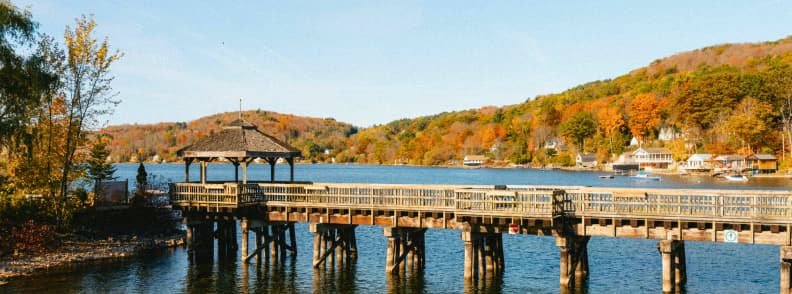
Planning Your Autumn Getaway
Good fall vacation planning starts long before you pack a bag. Shoulder season travel gives you cheaper flights, fewer crowds, and more authentic experiences, but timing matters. The best time to book is usually 6 to 10 weeks before departure, when airlines release unsold seats at lower fares. Prices drop further for midweek flights, especially on Tuesdays and Wednesdays. That’s when business travel dips, and leisure demand hasn’t yet peaked.
How to Plan an Autumn Vacation
Start with a realistic timeline. Twelve weeks before your trip, decide on your destination and a rough budget. At ten weeks, track flights and set up Skyscanner and Google Flights alerts for flexible dates. Eight weeks before, research accommodation and local transport. By six weeks, lock in your bookings to catch shoulder season deals. Four weeks out, check visa and entry rules and make sure your passport is valid for at least six months beyond your travel date. Two weeks before, review your travel insurance for autumn trips, schedule a flu shot, and download key travel apps like Trainline, Rome2Rio, and Google Maps offline for route planning.
Fall Booking Tips
Flexibility helps you save. Shift travel dates by a few days and compare nearby airports. Flying midweek often cuts prices by 15 to 25 percent. Choose early morning departures to avoid delays. When booking hotels, look for nonrefundable rates only if you are sure of your plans. Otherwise, the flexible option is worth a few euros more. Many smaller hotels close seasonally, so double-check opening dates before paying in advance.
Autumn Travel Checklist Timeline
- 12 weeks out: choose destination, budget, and research weather.
- 10 weeks out: set flight alerts and watch for price drops.
- 8 weeks out: compare lodging options, check refund policies.
- 6 weeks out: confirm bookings, plan transfers, and sign up for local event alerts.
- 4 weeks out: check passport, visas, insurance, and vaccinations.
- 2 weeks out: print or save digital copies of reservations.
- 1 week out: pack layers, check the weather, and confirm transport schedules.
Shoulder Season Travel Advantages
Traveling in the shoulder season keeps costs down and improves your experience. Museums and attractions are open but not crowded. Locals have more time to chat, and the pace is slower. You can enjoy meals without reservations and take photos without people in the background. Even popular regions like Provence or Tuscany feel peaceful once summer ends.
Health & Safety Before You Go
Early autumn often overlaps with flu season, so it’s smart to get vaccinated at least two weeks before travel. Review your travel and medical insurance to confirm coverage for delays and cancellations caused by seasonal storms. Always carry proof of insurance and know how to contact your provider abroad.
SafetyWing Nomad Insurance keeps you covered for medical emergencies, delays, and cancellations, anywhere in the world. Get flexible protection that adapts to your travel plans, not the other way around.
Avoiding Crowds
Plan your arrival and sightseeing for weekdays. Visit famous landmarks early in the morning or in the late afternoon. Pick off-peak destinations when possible. Instead of Paris, explore Lyon or Avignon. Swap Santorini for Naxos, or Dubrovnik for Šibenik. You’ll see more and spend less.
We live in the highly touristic region Provence-Alpes-Côte d’Azur. We always plan to visit popular destinations in the shoulder season, and we always see a huge difference vs. the summer. There are fewer tourists, better prices, and quiet cafés where locals know we aren’t rushing through. That’s how I learned that smart planning turns a short autumn escape into something that feels much longer.
Autumn Vacation Tip: Book flights around midweek, check your passport early, and set price alerts before the season shifts. The calm of shoulder season travel is worth every bit of preparation.
Where to Go in Autumn
The best autumn travel destinations combine comfort, color, and calm. Choosing where to go in autumn depends on your priorities: scenery, food, warmth, or culture. This is the season when Europe glows with harvest festivals, the USA in fall bursts with forest color, and the Southern Hemisphere warms into spring. Wherever you go, you’ll find lower prices and richer local life.
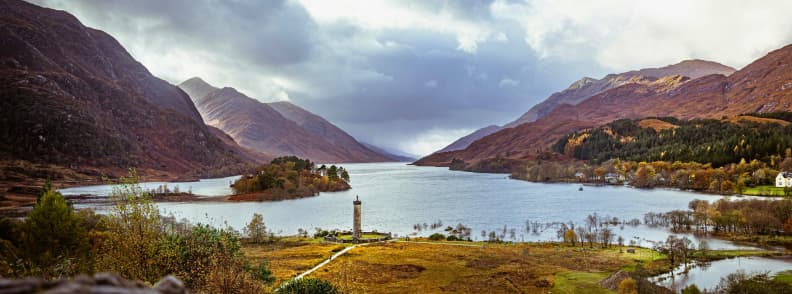
Europe in Autumn
Europe in autumn offers short flights, mild temperatures, and deep culture. In Tuscany, vineyards fade from green to gold while truffle hunters prepare their dogs for the season. In Bavaria, Alpine meadows turn amber, and small villages host beer and music festivals beyond Munich’s Oktoberfest. The Scottish Highlands are dramatic under low light, with mist rising from lochs and deer visible on the hills.
Alsace fills with wine tastings after harvest, and its half-timbered villages glow under strings of lights at dusk. Transylvania is cooler and moody, with fortified churches framed by forests of turning leaves. Provence, quieter than summer, smells of ripe figs and wood smoke. Slovenia’s lakes reflect mountain color, while Portugal stays sunny and ideal for autumn city breaks in Porto or Lisbon.
Average October temperatures across southern Europe stay near 18°C, while northern regions hover between 10 and 14°C. Flights drop by around 25% compared to July, according to current fare data. That mix makes Europe one of the best places to visit in fall for a balance between comfort and cost.
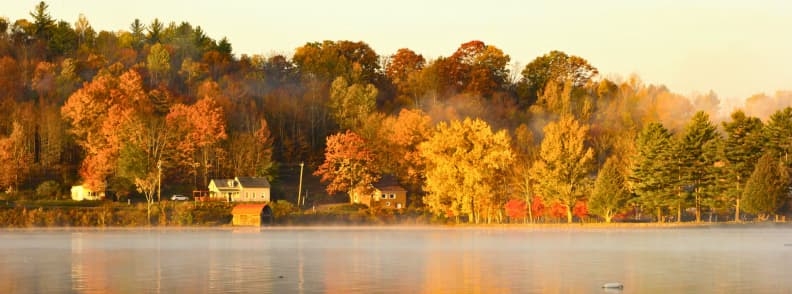
USA & Canada
Across the Atlantic, fall vacation spots in the USA and Canada focus on foliage and road trips. New England and Vermont dominate leaf-peeping maps with their red maple forests. The Smoky Mountains in Tennessee offer layered valleys where each ridge changes color at a different pace. Colorado shines with golden aspens against snow-dusted peaks. The Oregon wine country mixes harvest tasting rooms with scenic backroads perfect for weekend drives. National Parks like Yellowstone, Yosemite, and Acadia stay open but are crowded, ideal for hiking and photography. Foliage prediction tools help plan road trips at peak color.
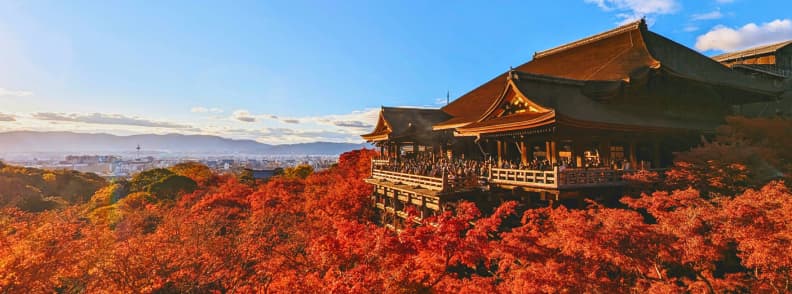
Asia in Autumn
In Asia, autumn means clarity after monsoon rains. Japan’s Kyoto transforms into a canvas of red maples around temples and gardens. Crowds gather, but respectful quiet still fills the parks. South Korea mirrors this rhythm with mountain trails in Seoraksan National Park. Vietnam cools slightly, especially in the north, making it comfortable for street food walks in Hanoi or lantern nights in Hoi An. This is the best time for travelers seeking calm weather without heat or humidity.
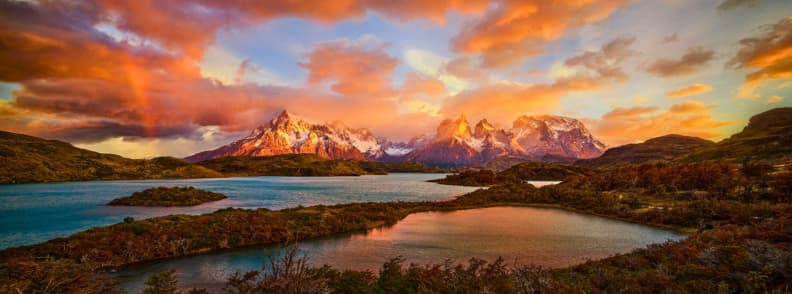
Southern Hemisphere Spring
For those craving warmth, the Southern Hemisphere offers spring instead of fall. Chile’s Lake District blooms with wildflowers, and Patagonia reopens for trekking. New Zealand’s South Island becomes green again, with fresh snow on peaks but mild valleys below. South Africa’s Cape region bursts into bloom, perfect for wine tasting and coastal drives under clear skies. Airfare to these destinations rises slightly compared to Europe, but you trade autumn chill for sunshine and long days.
Warm Escapes
If you need to stay warm in October or warm in November, pick southern destinations. The Canary Islands average 24°C with steady sun. Crete keeps its beaches open well into late autumn. Malta and Morocco combine culture with temperatures near 22°C. These are ideal fall vacation spots for travelers who prefer cafés by the sea to cold mountain walks.
Scenic Routes & Autumn City Breaks
Autumn rewards slow travel. Fall road trips through wine regions or scenic autumn train rides in Europe show landscapes at their best. The Glacier Express in Switzerland, the Douro Valley line in Portugal, and the Highlands train to Mallaig all offer windows onto golden hillsides. For autumn city breaks, smaller towns like Ljubljana, Coimbra, or Avignon keep energy without overwhelm.
When I think of quiet beauty, I think of Provence villages surrounded by lavender fields that fade to ochre in October. The markets slow down, but still smell of cheese and herbs. The café terraces fill with locals reading the paper, and the bakers set out warm fig tarts at nine. After summer’s crowds, it feels like life returns to normal and visitors are guests again, not intruders.
Slow Autumn Travel Tip: Choose one region and stay long enough to feel its rhythm. Visit vineyards midweek, take early morning walks, and use national weather or foliage maps to time your trip. Autumn rewards patience.

Experience Autumn Like a Local
The best autumn festivals reveal how a place truly lives once the tourists go home. Across continents, locals mark the season with harvests, food fairs, and family gatherings. These moments connect visitors to rhythms older than the calendar. They also bring the most authentic local food experiences of the year.
Harvest Festivals Around the World
Every country celebrates the end of harvest differently. In Europe, the wine harvest dominates the early season. Grapes fill crates across France, Italy, and Spain as farmers rush before the first rains. Villages host small dinners with fresh must and roasted meats. In Germany, markets open for Oktoberfest travel, where beer is poured straight from wooden barrels and the air smells of bread and pretzels. In Central and Eastern Europe, chestnuts roast in iron pans, and farmers sell jars of new honey. The apple season brings fairs like the National Apple Harvest Festival in Pennsylvania, mixing cider tastings with handmade crafts and hayrides. Each one feels rooted in the land.
Food & Wine in Autumn
Truffle season begins in late October and runs through winter. Markets in Provence and Piedmont sell small earthy treasures that perfume the air for blocks. Locals queue before dawn, tasting omelets shaved with the first truffles of the year. The Alsace wine fairs extend through November, offering tastings of new vintages in candlelit cellars. In Greece, the grape harvest turns into long lunches near the vineyards. In Romania, families make plum brandy, and the scent of boiling fruit carries through mountain villages. These celebrations are humble but warm, and travelers are welcome to join.
Cultural & Seasonal Celebrations
Outside Europe, fall traditions carry their own meanings. In the USA, Halloween travel brings haunted houses, pumpkin displays, and small-town parades. The Great Jack O’Lantern Blaze in New York State lines paths with carved pumpkins glowing against the night. Thanksgiving travel tips focus on gathering, with locals traveling home for family meals and festivals like the Santa Fe Wine & Chile Fiesta, where chefs showcase the last peppers of the season. The Natchez Balloon Festival paints the southern sky with color just as leaves fade. In Asia, Diwali travel glows with oil lamps and sweets, while in Mexico, Day of the Dead travel honors ancestors with marigolds and music. Every celebration blends food, faith, and light.
Markets in Autumn
Markets change character after summer. Produce stalls fill with pumpkins, mushrooms, pears, and walnuts. Bakeries display pies instead of fruit tarts. In northern regions, hunters bring in game meat, and restaurants create seasonal menus with venison, duck, and chestnut puree. Even in big cities, local markets remain the easiest way to taste the season. Wander early in the morning, buy bread still warm, and ask vendors for recipes. Locals will share them with pride.
I once spent a weekend at a truffle market in southern France. The square smelled of damp earth and garlic. Hunters stood behind tables lined with small paper envelopes, each holding a few grams of treasure. Some will let you lift the lid to smell a fresh truffle. It’s sharp, nutty, and cold like forest soil. People brought dogs, children, and baskets from the market. It felt less like shopping and more like community.
Fall Travel Advice: Plan your travels around one seasonal event instead of several. Choose a festival, arrive early, and stay nearby. You’ll eat better, spend less, and remember the people more than the souvenirs.

Fall Vacation Ideas for Different Traveler Types
Autumn travel fits every kind of traveler differently. The slower rhythm of the season makes it easier to design trips that match your pace and priorities. Whether you’re planning family fall vacations, romantic fall getaways, or a solo autumn escape, you can adapt the same regions and festivals to fit your travel style.
Romantic Fall Getaways
Romantic fall getaways are about comfort and calm. Short days encourage long dinners and early nights, while mild afternoons invite walks through vineyards or quiet towns. Small hotels and farm stays often offer lower rates once summer ends, making upgrades to rooms with terraces or fireplaces affordable. The best autumn settings for couples include wine regions, mountain cabins, and seaside spas where the last warmth of the year lingers. An autumn honeymoon works especially well in shoulder season Europe, when lavender fields are empty but markets are full. The stillness feels private, and every meal feels like a celebration.
Family Fall Vacations
Family fall vacations are easier to manage once the crowds thin. Attractions that were booked solid in August become peaceful again. School breaks in October align perfectly with city trips that mix education and fun. Choose kid-safe hikes with good paths, or pick museums that offer children’s programs during the holidays. Autumn is also better for budgets, since accommodation prices fall after summer. Families traveling by car can visit apple farms, small zoos, or heritage parks that are close by in late November. The key is to keep days shorter and include warm indoor breaks.
Solo Fall Travel Tips
Traveling alone in autumn is rewarding because locals have more time to talk. Solo fall travel tips focus on the community rather than the company. Pick destinations where walking and photography come naturally, such as Lisbon, Kyoto, or Edinburgh. Join small group tours or local cooking classes to meet people without pressure. Many hostels and guesthouses run off-season discounts, making it easy to extend your stay. The quieter atmosphere helps solo travelers slow down, think, and notice details missed in busier months.
Seniors Fall Travel Tips & Accessible Fall Travel
Seniors fall travel tips highlight comfort, good light, and easy transport. Temperatures stay pleasant and crowds thin, which makes sightseeing simpler. Seniors benefit from accessible fall travel options like river cruises, rail journeys, or single-base stays. Destinations such as Portugal, Austria, and Slovenia combine smooth infrastructure with compact old towns that are gentle to explore. The pace of the season matches the desire for unhurried discovery. Many museums and national parks also offer senior discounts during shoulder months.
When my husband and I travel in autumn, we notice how our rhythm changes. In Provence, we linger over long lunches and wander through vineyards without seeing another tourist. In La Réunion, we hiked more, using the cooler air to climb trails that would be punishing in their summer. The quiet evenings suit us, but I’ve learned to plan fewer stops per trip. One mistake was packing our days too tightly in Italy. It turned what could have been a peaceful week into a race between attractions. Slowing down has made every trip since then feel richer.
Autumn Travel Tip: Match your itinerary to your energy level. Couples can slow travel, families can focus on short day trips, solo travelers can join local groups, and seniors can choose rail or cruise options for comfort and access.

Packing & Safety
Packing for autumn is about readiness for change. A solid fall packing list lets you move easily between warm days, cool evenings, and sudden rain. Autumn rewards those who travel light but smart. A good base layer, reliable shoes, and a flexible wardrobe can keep you comfortable across climates from alpine trails to seaside towns.
Capsule Wardrobe for Autumn
A capsule wardrobe for autumn works best when divided by weather patterns. For cool-dry regions like Bavaria, Transylvania, or inland France, bring sturdy jeans, cotton shirts, and a medium-weight pullover. Add a waterproof jacket for wind and light showers. For cool-wet areas such as Scotland, northern England, or Belgium, focus on quick-dry fabrics, an extra fleece, and an outer shell that can handle daily drizzle. In warm-dry zones like southern Spain, Crete, or the Canary Islands, swap sweaters for linen layers and a single cardigan for evenings.
A 7 to 10 day wardrobe fits neatly in a carry-on if each item mixes with the others. Stick to neutral tones (gray, navy, olive) so you can rewear pieces without it showing. Include one outfit that feels slightly polished for nicer dinners, but keep comfort first. A small laundry pouch or travel-size detergent lets you refresh clothes mid-trip without overpacking.
Layering Done Right
Autumn layering is less about bulk and more about adaptability. Start with a thermal base that keeps heat in without weight. Add a fleece or wool mid-layer for insulation, then top it with a waterproof shell that shields from wind and rain. Accessories make the biggest difference. A thin scarf can block a breeze, and a beanie fits into any pocket. Gloves are worth packing even if you think the weather will stay mild, especially for early morning hikes or high-altitude drives.
For travelers shifting between regions, layers are essential. You might need short sleeves in Lisbon one day and a jacket in Porto the next. Carry a small cloth bag for your outerwear so you can store it neatly when the sun returns.
Footwear Essentials
Comfortable shoes are the backbone of a fall wardrobe. Waterproof boots for fall hikes protect against puddles and uneven ground, while cushioned sneakers work for cities and long airport walks. Choose breathable materials that dry overnight, and add an extra pair of socks in your day bag for emergencies. If your itinerary includes both city touring and rural walks, one neutral pair of boots can cover both. Avoid suede or light-colored shoes unless you enjoy scrubbing them clean.
For travelers spending evenings indoors, pack lightweight slippers or soft loafers. Hard floors in mountain guesthouses or old stone houses can get cold quickly. These small touches improve comfort without adding much weight.
Weather & Safety
Autumn weather can change within hours. Check the forecast each morning before leaving your accommodation. Carry a compact umbrella for passing showers, but when the wind picks up, rely on your jacket’s hood instead. On rural roads, fallen leaves make driving tricky. Road safety on wet leaves means braking gently and keeping a longer distance. Cyclists should add reflective bands or lights since daylight fades fast. If you’re hiking, start early to return before dusk, and bring a small flashlight just in case.
Shorter days also mean less natural light for photos or walking tours. Plan main activities before 4 PM, then shift to indoor attractions later. Hydration is still important even in cooler weather. Many travelers forget to drink enough water once the heat drops, which can cause fatigue during long sightseeing days.
Health Preparation
Autumn overlaps with cold and flu season. A flu shot two to three weeks before travel helps prevent mid-trip illness. Carry basic medicines for sore throats and colds, plus any prescriptions in original packaging. Review your travel insurance for autumn trips carefully. Policies that include coverage for weather delays, medical issues, and cancellations can save both stress and money. Keep digital copies of documents on your phone and one printed backup in your luggage.
With SafetyWing, you’re insured from the moment you leave home, with worldwide coverage and simple monthly payments. Perfect for fall road trips, slow travel, and long-term stays abroad.
If you rent a car in mountain or forest areas, verify that the insurance covers weather-related damage. Early snow is possible in places like the Alps or even the Pyrenees in late October. Always confirm emergency numbers for local healthcare or roadside assistance before setting out.
Autumn Holiday Tip: Plan outfits in layers, not categories. Every item should work with at least two others. Keep shoes versatile and waterproof, and always leave space for a rain jacket on top. A few smart choices keep you dry, warm, and ready for every kind of autumn weather.
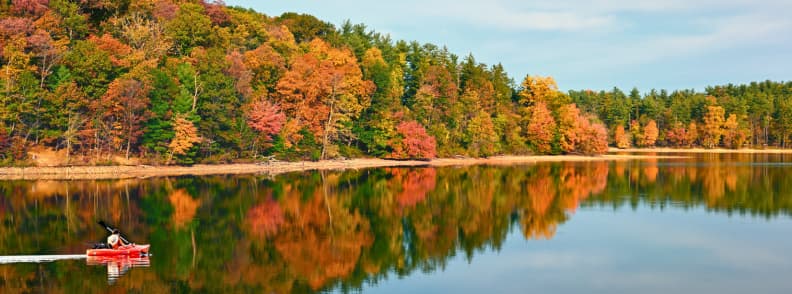
Seasonal Fall Activities & Outdoors
Autumn invites slower travel. Cooler air, softer light, and thinner crowds make it the best time for outdoor discovery. Hiking, cycling, and local markets feel calmer once the rush of summer ends. You see more, spend less, and return home with clearer memories of each place.
Best Fall Hikes
Some of the best fall hikes in the world take place under fiery leaves and crisp skies. The Smoky Mountains in the United States glow with layered shades of red and gold from late September to early November. Trails are accessible and well-marked, perfect for day hikers. In Europe, the Dolomites in northern Italy mix limestone peaks with larch trees that turn copper before winter. Trails around Ortisei and Alpe di Siusi are quieter than in July, and the light feels cinematic. On La Réunion, the trails of Mafate circle deep volcanic valleys surrounded by waterfalls and tree ferns. The mornings can start cold and misty, but the views once the sun breaks through are unforgettable.
Cycling in Autumn
Cycling in autumn brings balance between effort and comfort. Fewer cars on the road and cooler weather make long rides enjoyable. France’s Loire à Vélo and Austria’s Danube Path are perfect post-summer routes, with riverside cafés still open but half empty. In the Netherlands, locals continue cycling year-round, though autumn rain calls for good gear and lights. Pack gloves and a windproof jacket, and start rides midmorning when roads are dry. Stop in small towns for apple tarts or cider, the reward that turns cycling into leisure rather than sport.
Kayaking & Water Activities
Kayaking in autumn offers the quiet that’s hard to find in summer. Lakes and rivers mirror the colors of trees, and the water feels still. In Canada and Scandinavia, early mornings bring mist rising from the surface, ideal for photographers. Coastal kayaking in Portugal or Greece remains possible into October, with water temperatures around 20°C. Always check local weather, as strong autumn winds can change conditions quickly. Paddling near wildlife areas often brings close views of migrating birds before they head south.
Wildlife Watching in Fall
Migration defines wildlife watching in fall. In Scotland, red deer gather on moorlands during the rut, and their calls echo across valleys. In Canada, flocks of geese and cranes cross the sky in sweeping formations. Safari regions in South Africa offer spring births rather than autumn colors, giving travelers a glimpse of young wildlife before the dry season. Bring binoculars and neutral clothing, and move quietly. Patience is part of the experience.
City Walks & Autumn Markets
Even cities take on a new rhythm in fall. City walks in autumn are easier once the heat fades. Flea markets return, selling scarves, books, and ceramics under trees that shed yellow leaves. Paris, Vienna, and Budapest fill café terraces with locals sipping hot chocolate or mulled wine. Evening jazz and street performances move indoors, creating warm spaces full of life. Markets in fall showcase pumpkins, pears, mushrooms, and nuts. Visiting one early in the day gives you a window into local habits, with shopkeepers chatting, old men tasting cheese, and children helping parents choose apples.
Seasonal Activities for Families
Autumn is also the season for apple picking and pumpkin patches, especially in North America and parts of Europe. Families drive out to orchards, fill baskets, and sip warm cider afterward. Many farms open small markets selling pies, honey, and homemade jams. In places like Normandy or Vermont, these simple weekend rituals define local life. Visitors are welcome to join, and it’s one of the easiest ways to meet residents and learn local food traditions.
When I was a child in Romania, my parents took me for short hikes every autumn in the Bucegi Mountains. We’d start early, our breath white in the cold, climbing through forests that glowed orange and red. I remember the silence when the fog lifted and the way the light hit the cliffs. I’ve wanted to go back on those paths with my son, but today there are more brown bears in the area, and trails feel less safe. It’s strange how something once so familiar can shift with time. I guess this is why autumn travel feels different to me, it carries both beauty and nostalgia.
Autumn Travel Advice: Pack gloves and layers for outdoor days, plan hikes early, and visit markets midmorning before crowds. Autumn rewards those who rise with the light and pause when others rush past.
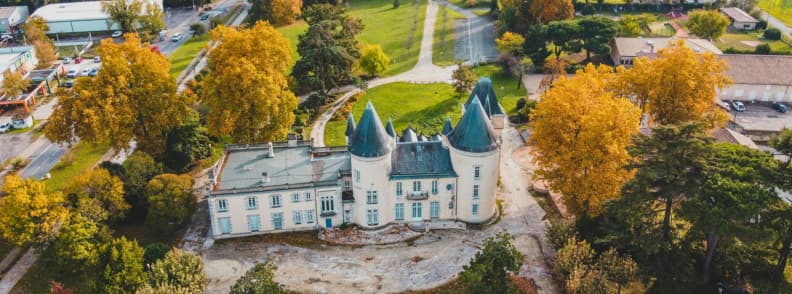
Autumn Vacation Budget & Fall Travel Deals
Autumn is the golden season for travelers who want comfort without high costs. Once schools reopen and the summer crowds disappear, airlines, hotels, and local businesses cut prices to attract visitors again. The result is a wave of fall travel deals that make it possible to explore more places for less money. Whether you are planning a short break in Europe or a longer trip abroad, this is when your travel budget stretches furthest.
How Much Does a Fall Vacation Cost
Understanding how much a fall vacation costs helps you plan better. A 3-day getaway within Europe averages around €300 per person, including flights and accommodation. A 7-day trip with midrange hotels and public transport falls between €800 and €1,000. For a 14-day multi-stop itinerary, expect roughly €1,800 to €2,000 depending on the destination. That’s often 25 to 40 percent less than summer prices. The savings come from cheaper airfare, shorter minimum stays, and lower restaurant markups once locals return to their routines.
Off-Peak Airfare & Hotel Savings
After the first week of September, airfare typically drops by 20 to 30 percent. Hotels follow the same trend, particularly in destinations driven by beach tourism. In southern Europe, a seafront room that costs €200 per night in August might drop to €120 or even €90 in October. Flights on Tuesdays or Wednesdays are the most affordable since business travel slows and weekend demand is low. Booking directly through airline apps often reveals flash sales that don’t appear on comparison websites. The same applies to boutique hotels, which frequently post autumn specials for direct bookings.
Cheap Fall Getaways & Shoulder Season Benefits
The best cheap fall getaways come from timing. Autumn sits between the high and low seasons, giving you sunny days and quiet streets without closures. Resorts in Crete, Malta, or southern Spain remain open through late October, offering all-inclusive stays at half the summer price. Wine regions like Bordeaux or Tuscany provide small inns where rooms drop by 30 percent after harvest. Many restaurants switch to seasonal menus, serving roasted chestnuts, mushroom risotto, and local game dishes that never appear in summer. Traveling during this window lets you experience authentic local life while spending less.
Reward Programs & Local Discounts
Autumn is also a good time to maximize discounts on fall travel through loyalty schemes and regional passes. Airlines promote double miles or bonus points during off-peak months. In Europe, city cards bundle public transport and attraction entries for a fraction of separate ticket prices. Museums and cultural sites often run free admission days to attract locals back. Smaller destinations publish restaurant vouchers or festival coupons through tourist offices. These are just a few easy ways to cut costs without effort.
Budget Transport With Low-Cost Trains & Buses
For travelers exploring Europe, FlixBus and regional train networks create some of the best autumn travel deals. Bus routes connecting Paris, Milan, and Vienna cost under €30 when booked ahead. Interrail autumn passes offer reduced rates for seniors and young travelers, ideal for those who prefer flexible itineraries. Traveling by train instead of flying not only saves money but also reduces airport stress and carbon footprint. Routes like Lyon-Avignon or Prague-Budapest show vineyards, forests, and rivers at their peak color, making the journey itself part of the reward.
How to Save Money on Fall Travel
To save money on fall travel, stay flexible. Adjust your travel dates by a few days and compare nearby airports. Flying into Marseille instead of Nice, or Venice instead of Milan, can save over €100 per ticket. When booking hotels, aim for Monday to Thursday stays because prices climb again on weekends due to local events. Dining where locals eat, taking regional trains, and skipping car rentals in well-connected cities also lower costs without limiting experiences.
Free Things to Do in Autumn
There are plenty of free things to do in autumn that add depth to your trip. Local harvest parades, food festivals, and market fairs open to everyone. National parks in Europe and North America often waive entrance fees during off-peak weekends. In cities, street art walks and outdoor photography become more pleasant in the mild air. Many churches, gardens, and museums remain free or donation-based once summer crowds vanish.
When I think about budget travel, I always remember my family trips to Greece in June or September. We went just at the start or at the end of school holidays when prices dropped, the sun was softer, and the beaches were half-empty. My father preferred the cooler air, and everyone loved that everything (from ferry tickets to taverna meals) cost less than in July or August.
That same pattern repeats in southern France today. I tell friends visiting me here to come in September or early October, when the weather is still warm enough for the sea, but hotel rates have already fallen. Even popular towns like Cassis and Saint-Rémy feel calmer and friendlier once the crowds leave.
Pro Travel Tip: Many small hotels and guesthouses quietly offer “locals’ rates” after mid-September if you call or email directly instead of using a booking site. Mention flexible dates and pay in cash, and you can often save 10 to 15 percent on the spot.

Autumn Weather & Timing
Planning around autumn weather helps you make the most of every trip. The season changes fast between September and November, but it’s also the most comfortable time to explore. Understanding autumn weather by month lets you match destinations with your tolerance for heat or cold, and to plan packing, activities, and travel timing with confidence.
September Has Warm Days & Clear Skies
September marks the true shoulder season across Europe and much of North America. Days stay long, with around 12 to 13 daylight hours depending on latitude. Average temperatures hover between 22°C in southern Europe and 16°C in central regions. The Mediterranean still feels summery, so this month suits late-summer travelers looking for warmth without the high-season chaos. Beaches in Italy, Greece, and Spain remain swimmable, while inland areas like Bavaria or Transylvania cool just enough for hiking. Rain is rare, though short evening showers can appear. It’s the ideal time for long road trips or scenic autumn train rides, with vineyards just starting to turn color.
October Brings Fall Colors & Calm
By October, fall foliage dominates northern destinations. Central Europe, Japan, and the northeastern United States reach peak fall color from early to mid-month. Average daytime temperatures range from 18°C in southern regions to 10°C in northern ones. October travel tips include packing layers for crisp mornings and warm afternoons. This is the best time to use a fall foliage map to follow color changes by region. Tools like SmokyMountains.com and Meteo France publish weekly predictions. Rain increases slightly in western Europe, so carry a light waterproof jacket or compact umbrella. Shorter days mean early sunsets, perfect for slow dinners and evening markets.
November Is Quiet & Cool
November travel tips focus on comfort and flexibility. Northern Europe cools quickly, averaging 5°C to 10°C, and early snow can appear in the Alps, Pyrenees, or Scottish Highlands. The south stays pleasant, often between 17°C and 20°C, which means travelers seeking warmth can still find destinations that feel like summer. The Canary Islands, Crete, and southern Portugal stay warm in November, with seawater around 21°C. This month is best for travelers who prefer solitude and cultural experiences over beaches. Rain becomes more frequent, especially along coasts, so plan backup rainy-day activities like museum visits, spa days, or cooking classes.
Average Temperatures and Daylight
| Region | September | October | November | Daylight Hours (approx.) |
| Southern Europe (Greece, Italy, Spain) | 22-28°C | 18-23°C | 16-20°C | 11-12 hours |
| Central Europe (France, Germany, Austria) | 18-24°C | 12-18°C | 7-13°C | 10-11 hours |
| Northern Europe (UK, Scandinavia) | 14-20°C | 8-14°C | 4-9°C | 8-10 hours |
| North America (Northeast USA, Canada) | 20-25°C | 10-17°C | 4-10°C | 9-11 hours |
| Southern Hemisphere (Chile, South Africa, New Zealand) | 16-20°C | 18-23°C | 20-26°C | 12-13 hours |
This simple breakdown shows how versatile autumn can be. You can chase warmth, color, or crisp air depending on what feels right for you.
Shoulder Season Timing
Understanding shoulder season timing helps you choose destinations that balance comfort and cost. In Europe, early September through mid-October is ideal. In the US, late September through early November gives peak foliage without extreme cold. In Asia, October is mild and dry, perfect for Japan, Korea, and Vietnam. The Southern Hemisphere experiences spring at the same time, with mild temperatures ideal for outdoor travel.
Warm Weather Escapes
For those who prefer steady sun, it’s still warm in October across the Mediterranean. Greece, Cyprus, and southern Italy offer beach conditions well into mid-October. By November, the warm in November zone shifts further south. The Canary Islands, Malta, and Morocco average 20°C to 25°C with light winds and minimal rainfall. These destinations stay lively without the crowds, giving travelers summer warmth at off-season prices.
Rain Gear & Practical Preparation
Autumn brings scattered rain showers but rarely long storms. A thin waterproof jacket, compact umbrella, and quick-dry shoes are enough for most situations. Roads can be slick with leaves, so allow extra travel time when driving. If you plan outdoor photography, carry a microfiber cloth for your lens and a plastic cover for your camera bag. After rain, the light turns golden and clear, ideal for capturing landscapes.
When I sailed through the Saronic Gulf in Greece one autumn, the weather stayed kind well into late October. Mornings felt warm enough for swimming, and the sea was calm. In the afternoons, a steady breeze carried the scent of pine and salt. By sunset, the islands looked painted in soft gold, and harbors were quiet except for a few fishing boats. Marina fees dropped after September, and so did hotel prices for those staying onshore. Even in November, my sailing school continued trips through the Cyclades, and people still swam off the back of the boat. It felt like summer had agreed to stay a little longer.
Fall Travel Tip: Check daylight hours before booking your activities, especially in northern destinations. Plan hikes and drives early, and save evenings for warm meals and local music. Autumn rewards those who follow the light.
Autumn Vacation Mistakes to Avoid
Even seasoned travelers make small errors when planning fall trips. The season rewards flexibility, but it also surprises those who treat it like summer. Knowing the most common autumn vacation mistakes can save you from frustration and extra costs.
Overpacking for the Wrong Weather
The first mistake is bringing too much. Autumn weather shifts between warm afternoons and cool nights, tempting travelers to pack their entire wardrobe. Heavy coats often sit unused, while lighter layers work better. Smart travelers focus on mix-and-match pieces that dry quickly and layer easily. Overpacking not only adds baggage fees but also makes moving between trains, ferries, or city apartments harder. I learned this on a trip to central Europe when I carried two jackets and wore only one. Now I pack less and wash more.
Misreading the Weather
Another common travel planning mistake in autumn is assuming the weather follows a clear pattern. Many travelers expect steady cool air, but conditions can swing from summer heat to winter chill in one week. Checking forecasts once before departure is not enough. I update mine daily on local apps like Météo-France or Windy. If the weather turns cold or rainy, adapt your plans instead of forcing outdoor sightseeing. Indoor attractions and market visits often feel cozier on cloudy days.
Booking Too Late
Last-minute bookings may work in low season but rarely in early autumn. The shoulder months attract travelers who chase good weather and lower prices, meaning the best-value hotels fill quickly. Waiting too long can double your costs. The safest window is to book 6 to 10 weeks before departure, when flights are cheapest and accommodation choice is still wide. I learned this while planning a family trip in Provence. I delayed booking, and the guesthouse I wanted was already full. The alternative cost twice as much and lacked the local charm I was hoping for.
Ignoring Daylight Changes
Ignoring daylight changes leads to missed hikes, photo sessions, and bus connections. By late October, sunset in northern Europe can come before 6 PM, catching travelers by surprise. Build shorter sightseeing days and leave evening hours for meals or music. If you love photography, check sunrise times too. The softest light often comes around eight in the morning. When we stayed near the Etang de Berre, I once forgot how early cafés closed off-season. We returned from a walk hungry, only to find every place shut by eight. Lesson learned, so now I always plan dinner earlier in autumn.
Skipping Travel Insurance
Skipping insurance remains one of the most expensive autumn vacation mistakes. Fall travel often overlaps with flu season and unpredictable weather. Cancellations and strikes also increase during these months. A good policy covers health issues, trip interruptions, and lost luggage. When booking through an airline, I always double-check coverage limits. Once, a flight cancellation left me stranded overnight in Milan, and my card’s built-in insurance covered the hotel stay. Without it, that night would have cost more than the flight itself.
SafetyWing Nomad Insurance covers you across borders and it’s ideal for spontaneous autumn escapes and extended European stays. Affordable, flexible, and built for digital nomads and independent travelers who value freedom and peace of mind.
Forgetting to Avoid Crowds Smartly
Most travelers assume autumn means empty attractions. That’s partly true, but not everywhere. Some events, such as wine harvests or city marathons, draw crowds even after summer. To avoid crowds in fall, travel midweek, book timed entry tickets, and arrive early at popular sites. You’ll enjoy museums and trails with minimal waiting. I often plan big visits right after opening, then spend afternoons exploring quieter neighborhoods.
Avoiding these simple errors turns a good trip into a great one. Autumn travel runs on timing and awareness more than luck. Once you learn how to balance preparation with spontaneity, the season rewards you with calm, beauty, and fewer surprises.
Autumn Travel Advice: Check opening hours carefully, especially in small towns. Off-season schedules shrink, and even restaurants may close early or only open a few days a week.
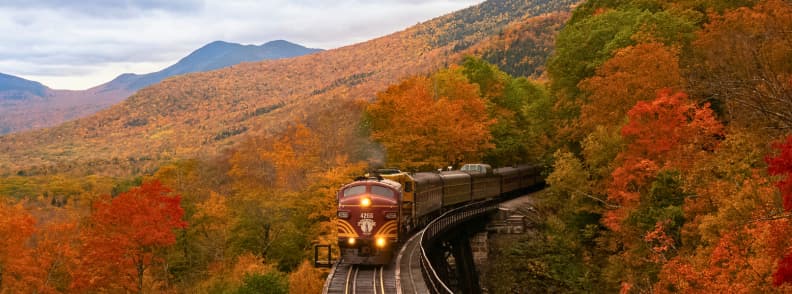
Slow & Eco Friendly Autumn Travel Tips
Autumn naturally encourages slower movement. The season’s rhythm aligns with mindful travel, where you take time to notice details instead of rushing between landmarks. Practicing eco friendly autumn travel doesn’t require dramatic changes, just conscious choices. Small decisions about how you move, where you stay, and what you buy shape your impact on the places you visit.
Choosing Scenic Autumn Train Rides & Public Transport
One of the simplest steps toward sustainable fall travel is choosing trains and public transport over short flights. Rail networks in Europe and Asia make it easy to move comfortably between cities while cutting emissions. A train trip from Paris to Amsterdam releases about 90 percent less carbon than the same journey by air. Modern high-speed trains are faster door-to-door once you count airport transfers and security. You also see more: rolling fields, vineyards, and changing leaves along the route. For regional trips, buses like FlixBus or BlaBlaCar add flexible, low-impact connections to smaller towns.
Staying Longer & Traveling Less
Slow travel in autumn works best when you stay longer in one place instead of hopping between destinations. A week in one region brings a richer sense of local life than three days in three cities. It also cuts your transport footprint and supports smaller communities that rely on steady visitors outside peak season. Renting an apartment or staying at a small inn helps you integrate into the local rhythm, with shopping at the weekly market, visiting nearby farms, or joining village festivals. You spend less time in transit and more time living like a local.
Supporting Local Businesses
Choosing to support local businesses makes your stay more meaningful and sustainable. Book family-run hotels, eat at neighborhood restaurants, and buy souvenirs made within the region. Autumn markets are ideal for this, selling seasonal produce, handmade ceramics, and textiles. Avoid chain stores when possible, and spread your spending across different shops instead of one big purchase. This approach keeps money in the local economy, which is especially valuable after the busy summer season ends.
Measuring Your Impact On The Environment
Understanding your travel carbon footprint helps you make smarter decisions. A one-hour flight emits about 250 kilograms of CO₂ per passenger, while a similar-distance train emits around 30. Choosing one rail journey instead of a short-haul flight can offset an entire week’s local travel by bus or metro. If flying is unavoidable, offset emissions through verified programs or choose direct routes, which use less fuel than connections. Packing light also reduces the plane’s total weight, lowering its energy use. Small actions add up, especially when many travelers adopt them.
Living the Season Naturally
Autumn’s slower pace makes it easier to travel mindfully. Take time to walk instead of calling taxis. Visit vineyards or farms that allow guests to help with harvests. Join foraging tours for mushrooms or chestnuts in rural France or Italy. These experiences teach how people live within the season rather than apart from it. They also connect travelers to nature in a grounded way.
When I first started paying attention to my travel habits, I noticed how much calmer trips became when I slowed down. In Provence, I once spent a week in one village instead of moving every two days. I got to know the baker by name, learned which market stall sold the best cheese, and realized that slower days left a smaller footprint and richer memories.
Little-known Fall Travel Tip: If you rent a car, ask for a hybrid or plug-in model and charge it overnight at your accommodation. In many European towns, parking is free for electric vehicles in autumn, saving both money and emissions.
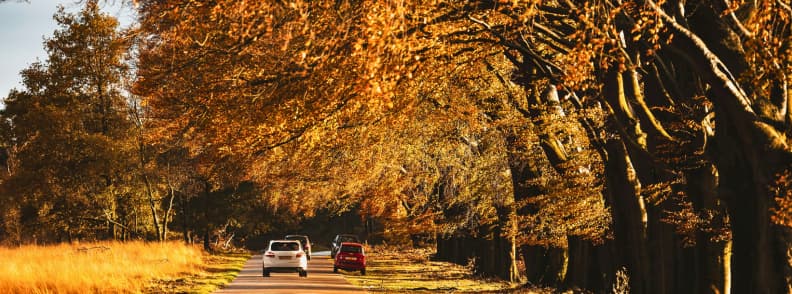
Autumn Transportation & Getting Around
Getting around efficiently during autumn travel depends on where you go and how fast you like to move. The season is perfect for road trips, scenic train rides, and short flights during the shoulder season when prices are lower and the crowds are gone. Each option brings its own rhythm, from slow countryside drives to panoramic train journeys through colored forests.
Best Fall Road Trips
Some of the best fall road trips in the USA and Europe reach their peak beauty in this season. In North America, drives through Vermont, the Blue Ridge Parkway, or Oregon’s coastal routes are legendary for foliage views and farm stops. In Europe, France’s Alsace Wine Route, Germany’s Romantic Road, and Italy’s Dolomites loop combine open roads with historic towns. Autumn brings lighter traffic and clear visibility, but daylight fades earlier, so aim to finish driving by late afternoon. Carry paper maps in case mountain roads lose signal coverage, and keep a thermos handy for roadside breaks.
Car Rental in Autumn
Booking a car rental in autumn is often cheaper than in summer. Rates can drop by 20 to 40 percent, especially in southern Europe, where demand falls after the beach season. Compact models work best for old towns with narrow streets, while hybrids are ideal for longer drives. Always check tire conditions before leaving, since some regions begin switching to winter tires by November. Ask about local toll systems and parking rules, as rural areas often lack clear signage. For savings, compare local companies to global brands. Smaller agencies frequently include insurance or unlimited mileage at lower rates.
Driving Safety & Wet Roads
Autumn roads bring beauty and risk. Driving tips for wet leaves include slowing down before corners and maintaining steady steering through shaded forest sections where roads stay damp. Leaves and fog reduce traction and visibility, so use headlights even during the day. Mountain routes may close temporarily for maintenance or snow, so verify local conditions before setting out. In areas like the Alps or Pyrenees, altitude changes quickly, and frost can form overnight. Keep extra water, snacks, and a blanket in the car for longer drives.
Scenic Drives & Visibility
Autumn is famous for scenic drives, but patience and awareness make them safer. Early mornings often bring fog, especially in valleys and near rivers. In Provence, where I live, rain is rare, but fog thickens before sunrise. On drives through vineyards and low hills, visibility can drop to a few meters. I always start later in the morning and keep the headlights on low beam to avoid glare. Once the fog lifts, the countryside glows gold and green, and traffic is light enough to pull over for photos. Local roads stay well-maintained, though rural parking can be limited around markets. Arriving early usually secures a safe spot before farmers’ vans fill the square.
Train Trips in Autumn
Trains are the easiest and most scenic alternative to driving. Train trips in autumn in Europe reveal landscapes that roads often miss, with valleys lined with vineyards, mountain ridges, and rivers reflecting autumn color. Routes like the Glacier Express in Switzerland, the Bernina line into Italy, and the Rhine Valley in Germany are especially striking. Public transport also saves parking stress in major cities. Autumn discounts appear on many passes, including the Interrail and Eurail passes, valid across 33 European countries. In Japan, the JR Pass remains active through autumn, offering unlimited rides on Shinkansen lines that cross through Kyoto and mountain towns during peak foliage.
Flights During the Shoulder Season
Short flights in the shoulder season remain useful for long distances, especially between islands or countries with limited rail links. Airfare usually drops between 20 and 30 percent from mid-September to late November. Flying midweek and choosing early morning departures further reduces costs. Regional airports are quieter, and security lines are shorter, making transfers smoother than in summer. For domestic trips under four hours, trains often rival flights in total time when you factor in transfers, but low-cost airlines fill the gap for travelers combining several countries.
Bus & Rail Passes
Bus and rail passes make regional exploration affordable. National networks like France’s SNCF, Spain’s Renfe, and Germany’s Deutsche Bahn sell seasonal tickets that bundle local travel for a set price. In Asia, long-distance buses in Vietnam or Japan offer reliable service even in rural areas, with low fares and flexible schedules. Autumn timetables often adjust for daylight, so always check last return times when planning day trips.
Autumn rewards slower travelers who adapt to changing light and weather. I often drive through the French countryside after sunrise, once the fog starts to thin. The air smells of wet earth, and visibility improves just in time to see the vines glowing in the sun. On days like that, I leave early markets for locals and take back roads through quiet villages. Even when travel slows, the experience deepens.
Autumn Safe Driving Tip: If you plan to drive in fog-prone regions, wait until visibility improves instead of rushing. A late start often brings better photos, safer roads, and less traffic.

Autumn Photography Advice
Autumn gives photographers the richest colors and the softest light of the year. The air turns clear after summer’s heat, and the lower sun angle paints everything in warm tones. Whether you use a phone or a full camera, understanding autumn photography is about chasing light and timing, not expensive gear.
Best Times of Day for Fall Photos
The best autumn destinations for photography look their finest when the light is low. Early morning and late afternoon bring texture to leaves and landscapes that harsh midday light flattens. Mornings often come with mist rising from rivers or lakes, adding atmosphere. The golden hour in autumn lasts longer than in summer because the sun sits lower on the horizon. Plan to shoot about thirty minutes after sunrise or before sunset, when trees glow orange and shadows stay soft. Even cloudy days help. Overcast skies make colors deeper and more balanced.
Camera Equipment for Fall
Good results come from simple, reliable gear. A mid-range zoom, like a 24-70 mm lens, covers everything from wide landscapes to closer details. A polarizer filter enhances sky color and reduces glare on wet leaves or water surfaces. A tripod keeps images sharp in lower light, especially for rivers or forests where long exposures create a dreamy look. Always carry spare batteries, as cold air drains power faster. A microfiber cloth is essential for clearing mist or drizzle off the lens without smudging. If you use a phone, clean the lens before each shot and tap to focus on midtones, not the brightest or darkest area.
Composing Autumn Foliage
Fall foliage photography benefits from simple composition. Look for contrast between colors, such as red trees against green grass, or yellow leaves reflected in water. Include foreground elements like fences or paths to lead the eye into the frame. When shooting forests, crouch low and aim upward to emphasize height. In open spaces, frame mountains or villages through branches. Avoid clutter by isolating one strong subject per image. To keep images balanced, divide scenes using the rule of thirds: one part land, two parts sky, or vice versa.
Capturing the Golden Hour & Sunrise
The sunrise in autumn often feels gentler than in other seasons. Cool air scatters light evenly, giving photographs a calm glow. Arriving early lets you capture frost or dew before it melts. Use manual settings or exposure compensation to prevent the bright sky from washing out detail. During the evening golden hour, find reflective surfaces like lakes, windows, or wet pavement to amplify the warm tones. If you are shooting in the city, position yourself where streetlights mix with natural light. This creates a cinematic mood unique to autumn.
Sharing & Inspiration
Sharing autumn images connects travelers worldwide. On social platforms, popular hashtags include #autumnvibes, #fallcolors, #autumnphotography, and #goldenhour. Pinterest boards dedicated to fall foliage photography gather thousands of examples from Europe, Japan, and the United States. Uploading your work there or to travel forums helps others plan budget fall trips based on what you’ve seen. Captions that mention location and timing, such as Kyoto in early November or Alsace vineyards at sunset, also boost visibility for travel communities.
When I first tried photographing sunrise in the French countryside, I underestimated the fog. The first frames looked white and flat. I waited, and fifteen minutes later the sun pierced through the mist, lighting the vineyards like they were on fire. The photos from that morning remain some of my favorites. Autumn rewards patience more than precision. Light changes every few minutes, and each shift brings something new.
Little-known Autumn Photo Hack: Carry a small spray bottle filled with clean water. A quick mist on dry leaves or rocks enhances reflections and color depth, making photos look as if they were taken right after rain. It works in forests, city parks, or anywhere the ground feels too dry for that glossy autumn glow.
Autumn Travel FAQ
Planning a fall trip brings a few recurring questions. This section answers the most common questions travelers ask when researching autumn travel tips, packing, and budgeting. Each answer is based on practical experience and current travel data, written to stay relevant year after year.
When is the best month for an autumn vacation?
The best month for an autumn vacation depends on what kind of experience you want. September offers the best balance of warm days and lower prices. October is perfect for color and cool air, while November suits travelers who prefer quiet towns and low costs. In Europe and North America, the second and third weeks of October often bring peak foliage and comfortable temperatures around 15°C to 20°C. In southern destinations, such as Greece or Portugal, the weather stays beach-friendly until late October.
Where should I go in the fall for foliage?
The most famous fall foliage regions are New England in the USA, the Canadian Rockies, the Dolomites in Italy, and the Japanese Alps. In Europe, the Alsace wine route and Slovenia’s Lake Bled combine mountain scenery with color-rich forests. Travelers looking for reliable timing can use a fall foliage map, such as SmokyMountains.com or National Weather Service updates, to plan around the color peak. Aim for highlands or lake regions where the temperature drops quickly, as leaves turn earliest there.
What do I wear on a fall vacation?
Knowing what to wear on a fall vacation means preparing for layers. Choose light, breathable fabrics under a waterproof shell or jacket. Jeans or travel trousers, comfortable shoes, and a warm sweater handle most climates. Pack a hat and scarf for cooler mornings and a thin shirt for midday warmth. Avoid heavy coats unless you expect mountain weather. Most travelers find that three upper layers (a base, a mid-layer, and a light jacket) cover every situation.
What should I pack for a week in autumn?
A one-week packing plan focuses on versatility. For what to pack for a week in autumn, include two pairs of trousers, one dress or outfit for evenings, three shirts, a sweater, a light jacket, underwear for a week, and waterproof shoes. Add a compact umbrella, power bank, reusable water bottle (many places have public fountains with potable water), and a small first-aid kit. If hiking, bring boots for fall trails and moisture-wicking socks. Rolling clothes instead of folding saves space, and packing cubes help organize by type.
How much does a fall vacation cost?
How much a fall vacation costs depends on location and length, but you can expect clear savings. A three-day city break averages €300 to €400 per person in Europe. A weeklong trip falls around €900, and two weeks reach roughly €1,800. Airfare and hotels drop 25 to 40 percent after summer, with the biggest difference in Mediterranean destinations. Rural stays and train travel also lower costs. The key is booking early and avoiding weekends in major cities.
How far in advance should I book my fall trip?
Booking 6 to 10 weeks in advance gives the best mix of price and availability. Airlines release discounted seats around that window, and small hotels still have a choice without summer demand. For special events like Oktoberfest or wine harvests, plan at least three months ahead. Early autumn travelers benefit from midweek bookings, which cost less and secure better check-in times.
How can I save money on fall travel?
To save money on fall travel, stay flexible with dates and airports. Use price alert tools like Skyscanner or Google Flights and compare midweek versus weekend fares. In Europe, trains and buses such as Interrail or FlixBus offer cheap alternatives to short flights. Book local guesthouses instead of chains, eat at lunchtime when menus are discounted, and look for regional passes that combine attractions and transport. Visiting smaller towns instead of capitals can cut total costs by half.
Where is warm in October and November?
If you prefer sun, many destinations stay warm in October and November. The Canary Islands, Crete, Cyprus, and southern Portugal keep daytime temperatures above 22°C. Morocco and Malta stay mild with long daylight hours. In Asia, Vietnam and Thailand are comfortable after the monsoon ends. In the southern hemisphere, Chile, New Zealand, and South Africa shift into spring, offering fresh weather for outdoor travel. Booking early ensures lower fares to these warm regions.
What fall festivals should I plan around?
Autumn is full of cultural and harvest festivals worth planning for. In Europe, Oktoberfest in Munich, the Alba Truffle Fair in Italy, and the Beaujolais Nouveau celebrations in France highlight the season’s flavors. The United States hosts the National Apple Harvest Festival in Pennsylvania and the Santa Fe Wine & Chile Fiesta in New Mexico. Mexico’s Day of the Dead in early November blends art and remembrance. Asia celebrates Diwali across India and Nepal, filling cities with lights and sweets. Checking local calendars helps you time your visit for the most vivid experiences.
Do I need travel insurance for autumn trips?
Yes, travel insurance for autumn trips is essential. This season overlaps with flu outbreaks and weather changes that can disrupt flights. A comprehensive policy covers cancellations, medical emergencies, and luggage delays. Many credit cards include travel protection, but always confirm coverage limits before departure. Choose an insurer that offers 24-hour support and reimbursement for weather-related cancellations, as storms and early snow sometimes affect mountain and island regions.
Even if you travel light, keep digital copies of your passport, insurance, and tickets stored safely online. It speeds up replacement or refunds if anything goes wrong during your autumn getaway.
How do I avoid crowds during peak foliage?
To avoid crowds during peak foliage, plan your visits for weekdays and arrive early in the morning. Popular trails and viewing points in the United States and Europe fill quickly once color forecasts peak. Staying outside major towns helps too. Choose smaller villages and drive in for hikes or viewpoints. In New England, base yourself in rural Vermont instead of near Boston. In Europe, skip the busiest weekends in places like Bavaria or Alsace and visit mid-October weekdays instead. Book timed-entry tickets for national parks in autumn or scenic autumn train rides in advance, and aim for sunrise walks when most travelers are still at breakfast.
What are the best romantic fall getaways?
The best romantic fall getaways combine privacy, nature, and good food. Couples often choose vineyard stays in Tuscany, cabins in the Austrian Alps, or spa towns in Slovenia. For city escapes, Bruges and Prague glow under warm streetlights once the crowds thin. In France, Provence and the Alsace wine route offer long lunches and small inns surrounded by autumn color. In North America, the Blue Ridge Mountains and the lakes of Vermont give space for quiet walks and cozy evenings by the fire. Early autumn honeymoons work well in southern Europe, while late October and November suit urban getaways with museums, markets, and candlelit dinners.
What are family friendly fall activities?
Families thrive in autumn because the pace of travel slows. Family friendly fall activities include apple picking, corn mazes, and pumpkin festivals in rural areas. In Europe, castle visits and small zoo parks stay open through October, offering cooler days without lines. Hiking short, safe trails with gentle slopes introduces children to nature at its most colorful. Many cities organize seasonal fairs, food markets, and harvest parades where kids can try local treats. Families traveling abroad should check school calendars. European destinations are quieter outside local autumn breaks, while U.S. parks are calm after Labor Day.
Are there eco friendly ways to plan an autumn trip?
Yes, several eco friendly ways to plan an autumn trip reduce impact without complicating your journey. Choose train travel over flights for distances under 1,000 kilometers. Stay in locally owned hotels that use seasonal produce instead of imports. Bring a reusable bottle and cloth bag to cut waste at markets. Visiting during shoulder season already helps the environment by spreading tourism evenly throughout the year. Supporting local artisans, avoiding single-use plastics, and eating regional foods all contribute to sustainable travel. If you rent a car, ask for an electric or hybrid model. Many European towns now offer free or discounted parking for low-emission vehicles.
How do shorter days affect my itinerary?
Shorter daylight hours in autumn change how you plan sightseeing. Start earlier in the day and finish outdoor activities by mid-afternoon. Museums, restaurants, and shops often close earlier than in summer, so confirm schedules before setting out. Lower sun angles also mean longer shadows, ideal for photography but limiting for hiking. In mountain regions, descending trails before sunset is safer, as temperatures drop quickly. Shorter days encourage a slower rhythm: late breakfasts, long lunches, and evening relaxation replace the rush of summer itineraries.
What camera gear is essential for fall photography?
Essential camera gear for fall photography includes a versatile 24-70 mm lens, a polarizing filter, and a sturdy tripod. Carry extra batteries since cooler weather drains them faster. A microfiber cloth keeps lenses clear in misty mornings, and a lightweight rain cover protects your camera during showers. If you use a phone, add a clip-on lens for wide landscapes and enable HDR mode to capture color depth. A remote shutter release or timer reduces shake for sharp long exposures. Always back up photos daily to a cloud service or SD card to avoid losing your best shots.
I always carry a small dry bag for my camera when hiking. Autumn mornings in Provence can start foggy, and the moisture collects fast. Keeping gear sealed until the air clears protects it and keeps lenses spotless for the perfect golden-hour shot.

Why Autumn Travel Is Worth Every Trip
Autumn rewards travelers who value calm, culture, and comfort. It offers the perfect mix of warm days, cool nights, and softer light that changes how you see familiar places. After summer crowds fade, landscapes open up, locals slow down, and the cost of travel drops. Flights, hotels, and restaurants all offer lower prices, turning dream trips into realistic plans.
The beauty of the season feels honest and unpolished. Vineyards turn gold, city parks fill with rust-colored leaves, and small markets replace souvenir stalls. Traveling now means meeting locals where they live, not just where they work. Meals stretch longer, and conversations with hosts or shopkeepers happen naturally. This balance between stillness and life makes autumn travel the most authentic time of year to explore.
Planning is simpler, too. Packing revolves around comfort, not fashion. Layered clothes handle temperature swings, and quieter schedules let you slow down without guilt. The season fits every traveler: families who want peace, couples who want romance, and solo explorers who want time to think.
Before you go, download my fall packing checklist and autumn planning timeline to prepare easily for your trip. Both guides save time, cut stress, and help you pack exactly what you need. Nothing more.
If you want fall vacation ideas, start with my Autumn Travel Guides, where I share personal tips and local insights from places around the world. Each guide includes firsthand advice, practical details, and experiences that help you see the season the way locals do.
The Travel Bunny’s Autumn Travel Tip: Wherever you travel, take one slow morning without plans. Walk to a café, order something warm, and watch the town wake up. That quiet moment is what autumn travel is really about.
About the author

I’m Mirela Letailleur, a Romanian travel writer based in the South of France and the creator of The Travel Bunny, where I share honest, experience-based travel guides for Europe and beyond. I specialize in affordable, slow, and cultural travel, helping readers plan smarter trips through local insight, not tourist checklists. Over the years, I’ve explored everything from Greek islands in September to Provence vineyards in autumn, always looking for the best ways to enjoy destinations at their calmest and most authentic.
My background in budget itinerary design and expat life in France helps me combine practicality with real experience. I write for travelers who value independence, food, and local connection, offering tested tips on autumn travel planning, off-season travel deals, and eco-friendly getaways. Through The Travel Bunny, I aim to show how timing your trip right can transform how you see Europe to be beautiful, affordable, and without the crowds.
For more fall vacation ideas, read these articles on The Travel Bunny
New Hampshire Fall Foliage. Best Scenic Drive Stops
Fall Foliage in Massachusetts: Best Stops on Leaf Peeping Trips
Fall Foliage in Maine. Must-Visit Stops on the Scenic Lakes & Leaves Route

